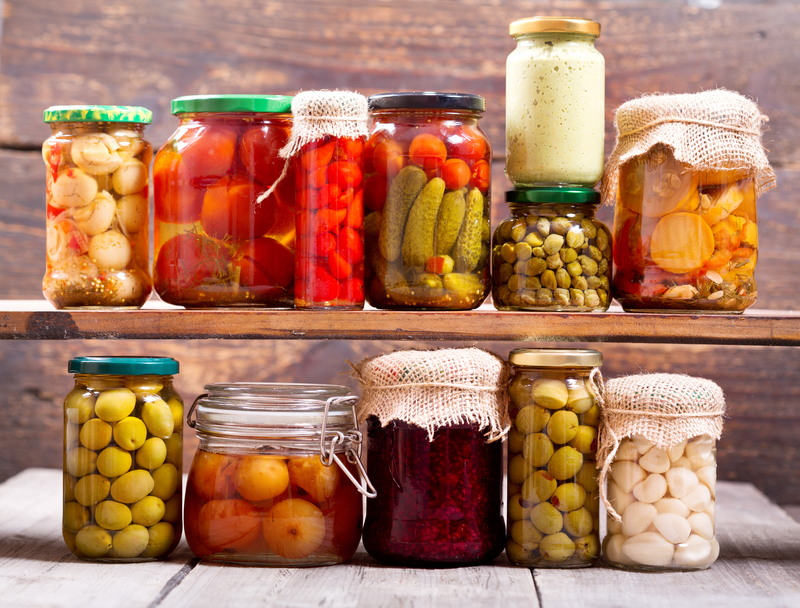Smart Solutions for Pots and Pans at End of Life
What happens to your cookware after it has served countless meals? Discover the innovative, eco-conscious, and practical smart solutions for pots and pans at end of life that benefit your kitchen and the environment.
Introduction: The Forgotten Lifespan of Cookware
Pots and pans are the backbone of every kitchen, enduring daily use and the demands of modern culinary creativity. Despite their importance, little thought is given to what happens once they've reached the end of their functional life. The disposal of old cookware, especially non-stick pans and metal pots, can significantly impact our planet. However, with growing awareness of sustainability, there are now smarter, greener solutions than simply tossing them in the trash. This article explores various sustainable options and practical ideas for giving your worn-out pots and pans a new purpose, ensuring your kitchen remains environmentally friendly from start to finish.

Why Rethink the End of Life for Pots and Pans?
Traditional disposal methods for cookware have severe environmental consequences. Many non-stick, aluminum, and stainless steel pans end up in landfills, where coatings and materials can take centuries to decompose or may leach harmful chemicals. Taking responsibility for cookware waste is not just a personal concern, but a global one.
- Waste reduction: Responsible disposal or upcycling minimizes landfill contributions.
- Resource conservation: Recycling recovers valuable metals and materials.
- Environmental health: Prevents toxic elements from contaminating soil and water.
- Creativity and sustainability: Repurposing offers new uses and inspires innovation.
Understanding the Main Types of Cookware Materials
Before exploring solutions for old cookware, it helps to identify what your pots and pans are made from. The solution for end-of-life pots and pans varies depending on their material:
- Stainless steel: Highly recyclable and durable, often upcycled or transformed.
- Aluminum: Lightweight and recyclable but may have non-stick coatings.
- Copper: Valuable for scrap, requires special recycling procedures.
- Cast iron: Rarely discarded, can usually be restored or repurposed.
- Non-stick (Teflon or ceramic-coated): More complex; not all recycling centers accept them.
Knowing the base material enables you to choose the best eco-friendly solution.
Smart Solutions for Old Cookware
1. Recycling Pots and Pans the Right Way
Can you recycle old pots and pans? In many cases, yes! Metal cookware can be recycled, but only if processed correctly:
- Remove non-metal parts: Take off handles, glass lids, and plastic parts, which may need to be disposed of separately.
- Contact local recycling centers: Some accept metal pots and pans at end of life, especially those made from stainless steel or aluminum.
- Check for scrap yards: Metal scrapyards often accept pots, pans, and even copper cookware, offering cash for certain metals.
- Avoid curbside recycling bins: Most municipal programs don't accept large metal items with household recycling.
Tip: If the pan is non-stick, check if the coating must be removed before recycling. Some programs require this, while others don't accept non-stick at all.
2. Donating Usable Cookware
Not all cookware at the end of its life is completely unserviceable. If your old pots and pans are only lightly used, still in fair condition, or simply don't fit your needs anymore, donate them to:
- Shelters or soup kitchens
- Charity shops or thrift stores
- Community centers or kitchens
- Friends, students, newlyweds, or those setting up a first home
3. Upcycling and Repurposing Old Pots and Pans
Get creative! One of the greenest end-of-life solutions for old cookware is upcycling. Repurposing transforms pots and pans into useful or decorative items, minimizing waste and adding charm. Here are some innovative ideas:
- Planters: Drill holes in the bottom and use them for herbs or flowers.
- Bird feeders or baths: Hang or mount them in your garden.
- Wall art and clock faces: Paint or craft unique kitchen decor.
- Storage containers: Organize tools, gadgets, or stationery.
- Lampshades: Retrofit pans into quirky industrial-style lamps.
- Candle holders or centerpiece bowls: Perfect for rustic table settings.
Upcycling pots and pans at end of life saves resources and lets your creativity shine.
4. Return, Exchange, or Take-Back Programs
Many cookware manufacturers and retailers offer take-back or exchange programs for their products at end of life. These programs are designed to keep used cookware out of landfills:
- GreenPan, Le Creuset, and other brands recycle your old pans when you purchase new ones.
- Retailers like IKEA or Williams Sonoma sometimes have recycling drop-off points or trade-in events.
- Check manufacturer warranties: Some high-end brands replace or recycle cookware with defects or wear, often at little or no cost.
If your cookware brand offers any "cradle-to-cradle" or take-back initiatives, use them for responsible, streamlined disposal.
5. Professional Restoration and Recoating
For high-quality cookware--especially cast iron, carbon steel, or stainless steel--consider professional restoration or recoating services:
- Re-seasoning or re-enameling: Restores non-stick and rust resistance to pans.
- Re-tinning: Gives copper pots new life by applying a fresh tin lining.
- Professional cleaning and polishing: Removes years of tarnish and damage.
Choose this if you have heirloom cookware or expensive brands. Restoration often costs less than buying new and reduces waste.
6. Composting Biodegradable Components
Some newer eco-friendly brands offer pots and pans made with biodegradable or compostable handles and parts. If your cookware features these bio-based elements, cut them off and add them to your compost once separated from the metal components.
What About Specific Cookware Types?
Non-Stick and Teflon-Coated Pans
Dealing with non-stick pans at end of life is tricky due to PTFE (Teflon) coatings that make recycling more challenging. Here's what you should do:
- Recycle if possible: Contact recycling centers directly to see if they accept non-stick items.
- Use manufacturer take-back: Many brands have dedicated recycling systems for their products.
- Upcycle non-cooking uses: Convert into non food-contact planters, organizers, or art.
- Never burn or incinerate non-stick pans: This releases harmful chemicals.
Cast Iron and Carbon Steel Pans
Because of their durability, cast iron pans rarely need retiring. However, extremely damaged, cracked, or heavily rusted pans can be:
- Sent to metal recycling
- Restored or re-seasoned
- Made into garden or shop tools
Consider using vintage or heirloom cast iron for creative purposes, or donate to collectors and restoration experts.
Copper Cookware
Copper pans, if not suitable for kitchen use, are valuable for scrap and can be recycled at most metal scrapyards. Additionally, the beautiful patina of aged copper makes them ideal for upcycling into decor or unique planters.
Glass, Enamel, and Ceramic Cookware
Glass and ceramic pans are generally not accepted with glass bottle recycling due to different melting temperatures. However, they can be:
- Repurposed for storage or serving (if intact)
- Turned into garden markers, art, or mosaics (if broken)
- Brought to municipal recycling centers specializing in ceramics
How to Tell It's Time for Cookware Replacement
Sometimes, it's hard to know when a pan is truly at end of life. Here are signs you should replace your pots and pans:
- Warps, cracks, or holes
- Extensive rust or pitting (especially on cast iron)
- Loose or broken handles that can't be repaired
- Major loss of non-stick coating--peeling or flaking is unsafe
- Persistent odors or stains that can't be cleaned
Replacing cookware at the right time keeps your cooking safe and healthy.
How to Prolong the Life of Pots and Pans
Before considering disposal, take steps to extend the life span of your cookware:
- Avoid metal utensils on non-stick surfaces
- Hand-wash instead of dishwashing when possible
- Properly dry and store after cleaning
- Re-season cast iron and carbon steel
- Tighten or replace loose handles
Good care means fewer pots and pans reach end of life each year!

Eco-Friendly Brands and Future Innovations
Leading brands are developing sustainable solutions for cookware. Some use recycled materials in production, offer lifetime repair/replacement warranties, or sell modular pots with replaceable parts.
- Always: Offers take-back and recycling for old cookware when you purchase new.
- GreenLife: Uses upcycled aluminum and eco-friendly ceramic coatings.
- De Buyer, Le Creuset, and Lodge: Provide restoration services and promote sustainable product lifecycles.
With green innovations, the future of pots and pans at end of life looks brighter.
Conclusion: Smarter Kitchen Choices for a Greener Planet
Being mindful of what happens to your pots and pans at end of life makes a big difference. Whether you recycle, upcycle, restore, or donate, each step reduces landfill waste, protects the environment, and breathes new life into old materials. Choosing smart solutions for used cookware is a powerful way to extend the story of your kitchen, showing that sustainability and culinary passion can indeed go hand in hand.
Make a pledge today: Before discarding, explore recycling options, creative repurposing, or participation in take-back programs. Together, we can forge a kitchen culture that is as good for the earth as it is for our cooking!
Looking to replace your old cookware with sustainable choices? Consider eco-friendly brands and always check for recycling or donation programs before buying new. Your green kitchen revolution starts with how you say goodbye to your pots and pans.
Frequently Asked Questions (FAQs) on Pots and Pans at End of Life
-
Can I recycle all types of pots and pans?
Not always. Metal pans can often be recycled, but non-stick and composite pans may need special collection. Check with your local center. -
What should I do if my cookware is in good condition, but I don't want it?
Donate to local charities, shelters, or via online community groups. Someone else can extend its useful life. -
Is it safe to use pots and pans with damaged non-stick coatings?
No. Flaking coatings can be hazardous. Dispose responsibly or upcycle for non-cooking uses. -
Where can I find inspiration for upcycling my old pans?
Look on Pinterest, DIY blogs, and sustainability forums for creative repurposing guides!
